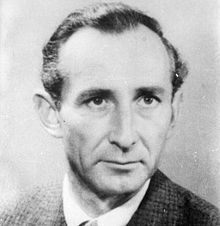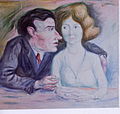Erwin Wendt
Robert Erwin Johannes Wendt (born April 3, 1900 in Liebenwerda ; † February 15, 1951 in Bielefeld ) was a German painter .
life and work
Erwin Wendt grew up as the son of the master carpenter Robert Wendt and his wife Emma Haupt in Liebenwerda. In autumn 1917 he began studying with Professor Paul Rößler at the State Academy for Applied Arts in Dresden , but then served as a soldier during the First World War . After the end of the war he continued his studies with Rößler in January 1919 and finished it in July 1926 with the degree of master class . In 1927 Erwin Wendt moved from Dresden to Düsseldorf , where he created a substantial part of his works. Initially he worked as a designer in the Sichtermann & Edelmann studio. In 1928/29 he became a student of Professor Heinrich Campendonk at the State Art Academy in Düsseldorf and went on a study trip to Holland . From 1929 he was freelance and became a member of the artists' associations Das Junge Rheinland , to which Otto Dix also belonged, and the Rheinische Secession . In 1935 Erwin Wendt married his long-time girlfriend Katharina Henriette (Käthe) Termeer (* 1909; † 1986). In the following year the couple moved to Bielefeld because Erwin Wendt was able to earn his living there by commissioning wall painting. The marriage remained childless. During the Second World War , Erwin Wendt served as a soldier from 1940 until the end of the war in 1945.
Most (and most important) of his works were bequeathed by his widow shortly before her death to the Kunstmuseum Düsseldorf (now the Museum Kunstpalast ) and the Stadtmuseum Düsseldorf , some also to the Kunsthalle Bielefeld .
Works in examples
Exhibitions
Solo exhibitions
- 1946 Bielefeld, Otto Fischer art dealer
- 1948 Münster, Clasing art dealer
- 1951 Bielefeld, Städtisches Kunsthaus
- 1951 Witten, Märkisches Museum
- 1957 Herford, Municipal Museum
- 1970 Bielefeld, Kunsthalle
- 1976 Paderborn, Municipal Gallery
- 1979 Oerlinghausen, art association, synagogue
- 1981 Münster, Westphalian State Museum for Art and Cultural History
- 1981 Düsseldorf, City Museum
- 1985 Bielefeld, Waldhof Museum of Cultural History
- 1987 Düsseldorf, City Museum
- 1997 Düsseldorf, City Museum
Group exhibitions
- In the years 1929–1933 numerous exhibitions with the artists' associations Das Junge Rheinland and Rheinische Secession
- 1935 Mönchen-Gladbach, House of Art
- 1946 Bielefeld, Oetkerhalle
- 1948 Bielefeld, art in Din format
- 1952 Witten, Märkisches Museum
- 1953 Hanover, Art Association
- 1953 Bielefeld, Städtisches Kunsthaus
- 1954 Bielefeld, Städtisches Kunsthaus
- 1969 Gütersloh, Kupferstichkabinett
- 1979 Bielefeld, Kunsthalle
- 2001 Bielefeld, Historical Museum
- 2019 Düsseldorf, Kunstpalast
literature
- Erwin Wendt, 1900–1951: paintings, watercolors, drawings. Städtisches Kunsthaus Bielefeld, 1951 (exhibition catalog)
- Erwin Wendt . In: Hans Vollmer (Hrsg.): General Lexicon of Fine Artists of the XX. Century. tape 5 : V-Z. Supplements: A-G . EA Seemann, Leipzig 1961, p. 110 .
- Bielefelder Kunstverein: Art of the XX. Century from the property of the art association and its members. Bielefeld 1954 (exhibition catalog)
- Wendt: Oil paintings, collages, mixed media, watercolors, linocuts, drawings. Municipal Gallery Paderborn, 1976 (exhibition catalog)
- From private ownership in Bielefeld: painting and graphics 1900–1945. Kunsthalle Bielefeld, 1979 (exhibition catalog)
- Wendt: 17 pen drawings from 1928, 1980 (reproduced manuscript)
- Christa Gränitz, Katharina Wendt (Red.): Erwin Wendt: Works 1928–32. Edition Marzona, Bielefeld / Düsseldorf 1981, ISBN 3-921420-14-6 .
- Hans F. Schweers: Paintings in German museums: catalog of the works exhibited in the Federal Republic of Germany. Saur, Munich 1982, ISBN 3-598-10310-7 .
- Erwin Wendt: Works 1927–1951, paintings, collages, watercolors, drawings. with a contribution by Rüdiger Jörn and a foreword by Florian Böllhoff, Kulturhistorisches Museum Waldhof Bielefeld, 1985 (exhibition catalog)
- Ulrich Krempel (ed.): In the beginning: The young Rhineland, On the art and contemporary history of a region 1918–1945. Claassen, Düsseldorf 1985, ISBN 3-546-47771-5 (also exhibition catalog)
- The Erwin Wendt donation: paintings, graphics. with a contribution by Friedrich W. Heckmanns and a foreword by Wieland Koenig, Stadtmuseum Düsseldorf, 1987 (flyer for the exhibition)
- Stadtmuseum Düsseldorf (ed.): The young Rhineland. An idea of peace. Claassen, Düsseldorf 1988, ISBN 3-546-47772-3 (also exhibition catalog)
- Ernst Termeer (Ed.): Wendt: Café house sketches. Düsseldorf 1997 (brochure)
- Ernst Termeer (Ed.), Sigrid Kleinbongartz (Red.): Erwin Wendt 1900–1951: Painting and graphics. Foundation to the Kunstmuseum Düsseldorf and the Stadtmuseum Düsseldorf, with contributions from Bettina Baumgärtel, Ernst-G. Güse, Sigrid Kleinbongartz, Wieland Koenig, Ernst Termeer, Stephan von Wiese and a greeting from Marlies Smeets, 1997 (exhibition catalog)
- Sonja Biermann: The Young Rhineland and its artist festivals. Cologne 1999 (written term paper as part of the first state examination at the educational science faculty of the University of Cologne)
- Art life 1945–1960: Wendt, Heiner , Kraft and the Bielefeld art scene. with a contribution by Gerhard Renda and a foreword by Cornelia Foerster and Gerhard Renda, Historisches Museum Bielefeld, 2001 (exhibition catalog)
- Gerhard Renda: A colorful soldier film - Erwin Wendt and the artistic equipment of the Bielefeld barracks. In: Ravensberger Blätter. Issue 2, 2002.
- Ernst Termeer: My little collection. Siegelverlag Termeer, Düsseldorf 2008
Web links
- Literature by and about Erwin Wendt in the catalog of the German National Library
- An insight into the artist festivals of the association Das Junge Rheinland , in which Erwin Wendt played a key role, is offered by the example of Der ungesselte Zoo (1930) on the Eifel und Kunst site .
Individual evidence
- ↑ See the biography of Sigrid Kleinbongartz in: Ernst Termeer (Ed.), Sigrid Kleinbongartz (Ed.): Erwin Wendt 1900–1951: Painting and graphics. Foundation to the Kunstmuseum Düsseldorf and the Stadtmuseum Düsseldorf, 1997, p. 47 ff., The memories of Ernst Termeer, ibid, p. 55 ff .; Ernst-G. Güse: Erwin Wendt in Düsseldorf. In: Christa Gränitz, Katharina Wendt (Red.): Erwin Wendt: Werke 1928–32. Edition Marzona, Bielefeld / Düsseldorf 1981 and Erwin Wendt - life data. ibid.
- ↑ Images with the designation “Privatbesitz Wittenbach / SG” are photographs of the originals. Images labeled “Privatbesitz Düsseldorf” are scans from Ernst Termeer: My Small Collection. Siegelverlag Termeer, Düsseldorf 2008, with the consent of the author and publisher Ernst Termeer.
- ↑ From right to left: Erwin Wendt, his wife Käthe Termeer, the painter Pitt Kreuzberg (?) [According to tradition in the family]
- ↑ The painter Pitt Kreuzberg and his wife Helene Gertrude Boosen [according to tradition in the family]
- ↑ Also known under the title Pilgrims before Rome [according to tradition in the family].
- ↑ Erwin Wendt as a teacher and his nephew Norbert Reetz (?) As a student [according to tradition in the family]
- ↑ Also known as Men in Tons . See Ernst Termeer: My small collection. Siegelverlag Termeer, Düsseldorf 2008, p. 56.
- ↑ a b cf. on this (until 1981): Christa Gränitz, Katharina Wendt (Red.): Erwin Wendt: Werke 1928–32. Edition Marzona, Bielefeld / Düsseldorf 1981.
- ↑ There are illustrations on p. 86 and p. 92.
- ↑ Depicted therein: The magic ball. 1946, oil on plywood, 30.5 × 43.5 cm and Death in the Steppe. 1948, oil on hardboard, 43 × 50 cm.
- ↑ It shows: Jewish woman with pigeons. around 1932, oil on canvas, 84 × 55 cm, Stadtmuseum Düsseldorf, p. 231.
- ↑ Short biography on p. 175 and the following illustrations: Jewess with pigeons. around 1932, oil on canvas, 84 × 55 cm, Stadtmuseum Düsseldorf, p. 79; War. 1934, reverse glass painting, 33 × 43 cm, Stadtmuseum Düsseldorf, p. 139; At the crossroads. 1947, oil on canvas, 49 × 63 cm, Stadtmuseum Düsseldorf, p. 145.
- ↑ In it numerous photos and the illustration of metropolitan. around 1928, collage (Fig. 24).
- ↑ Depicted therein: Self-portrait as a harlequin. 1946, oil on canvas, 50 × 38 cm, Stadtmuseum Düsseldorf (p. 47); Girl, death and the devil. around 1946, pencil drawing, 42 × 30 cm, Kunsthalle Bielefeld (p. 21); Men in Barrels. 1947, oil on canvas, 52.5 × 61 cm, private collection, Düsseldorf (p. 35); Old town Nicolaikirche in ruins. 1948, oil on canvas, 50 × 42.5 cm, Stadtmuseum Düsseldorf (p. 29); Death in the steppe. 1948, oil on hardboard, 43 × 50 cm, Kunsthalle Bielefeld (p. 48); Goblins. 1949, watercolor, 30 × 48 cm, private collection, Düsseldorf (p. 37); Robbery of Europe. around 1949/50, glue paints, 47 × 61 cm, private collection, Düsseldorf (p. 42); Odysseus and Nausicaa. Glue paints, 45 × 61 cm, private ownership, Düsseldorf (p. 56); Descending prophets. around 1949/50, sepia drawing, 52.5 × 64 cm, private collection, Düsseldorf (p. 24).
- ↑ It contains 57 colored illustrations of the works of Erwin Wendt.
| personal data | |
|---|---|
| SURNAME | Wendt, Erwin |
| ALTERNATIVE NAMES | Wendt, Robert Erwin Johannes (full name) |
| BRIEF DESCRIPTION | German painter |
| DATE OF BIRTH | April 3, 1900 |
| PLACE OF BIRTH | Bad Liebenwerda |
| DATE OF DEATH | February 15, 1951 |
| Place of death | Bielefeld |













